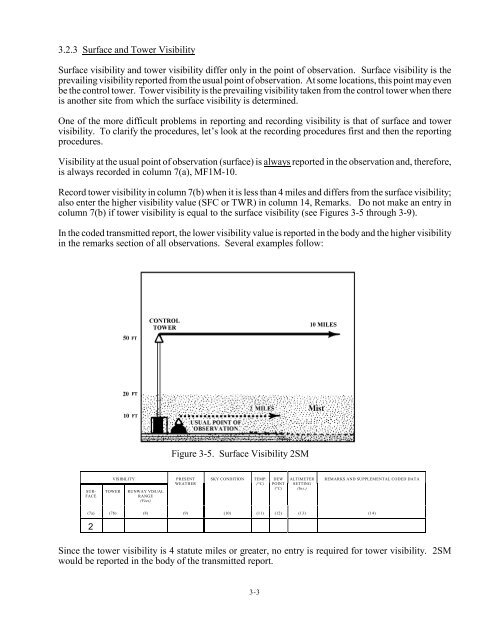Training Guide in Surface Weather Observations - Multiple Choices
Training Guide in Surface Weather Observations - Multiple Choices
Training Guide in Surface Weather Observations - Multiple Choices
Create successful ePaper yourself
Turn your PDF publications into a flip-book with our unique Google optimized e-Paper software.
3.2.3 <strong>Surface</strong> and Tower Visibility<br />
<strong>Surface</strong> visibility and tower visibility differ only <strong>in</strong> the po<strong>in</strong>t of observation. <strong>Surface</strong> visibility is the<br />
prevail<strong>in</strong>g visibility reported from the usual po<strong>in</strong>t of observation. At some locations, this po<strong>in</strong>t may even<br />
be the control tower. Tower visibility is the prevail<strong>in</strong>g visibility taken from the control tower when there<br />
is another site from which the surface visibility is determ<strong>in</strong>ed.<br />
One of the more difficult problems <strong>in</strong> report<strong>in</strong>g and record<strong>in</strong>g visibility is that of surface and tower<br />
visibility. To clarify the procedures, let’s look at the record<strong>in</strong>g procedures first and then the report<strong>in</strong>g<br />
procedures.<br />
Visibility at the usual po<strong>in</strong>t of observation (surface) is always reported <strong>in</strong> the observation and, therefore,<br />
is always recorded <strong>in</strong> column 7(a), MF1M-10.<br />
Record tower visibility <strong>in</strong> column 7(b) when it is less than 4 miles and differs from the surface visibility;<br />
also enter the higher visibility value (SFC or TWR) <strong>in</strong> column 14, Remarks. Do not make an entry <strong>in</strong><br />
column 7(b) if tower visibility is equal to the surface visibility (see Figures 3-5 through 3-9).<br />
In the coded transmitted report, the lower visibility value is reported <strong>in</strong> the body and the higher visibility<br />
<strong>in</strong> the remarks section of all observations. Several examples follow:<br />
SUR-<br />
FACE<br />
VISIBILITY PRESENT<br />
WEATHER<br />
TOWER RUNWAY VISUAL<br />
RANGE<br />
(Feet)<br />
Figure 3-5. <strong>Surface</strong> Visibility 2SM<br />
SKY CONDITION TEMP.<br />
(°C)<br />
3-3<br />
DEW<br />
POINT<br />
(°C)<br />
ALTIMETER<br />
SETTING<br />
(Ins.)<br />
REMARKS AND SUPPLEMENTAL CODED DATA<br />
(7a) (7b) (8) (9) (10) (11) (12) (13) (14)<br />
2<br />
S<strong>in</strong>ce the tower visibility is 4 statute miles or greater, no entry is required for tower visibility. 2SM<br />
would be reported <strong>in</strong> the body of the transmitted report.

















